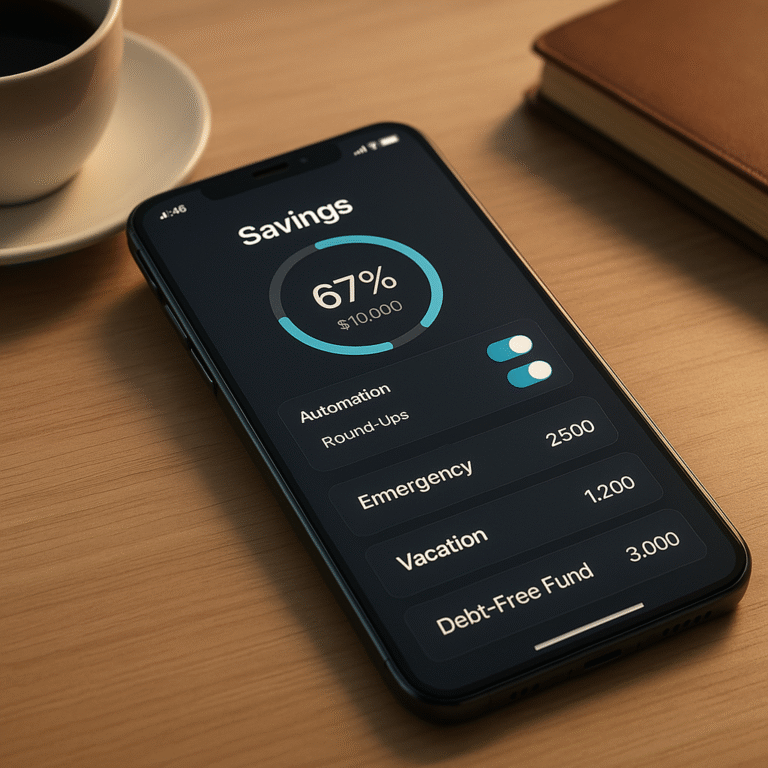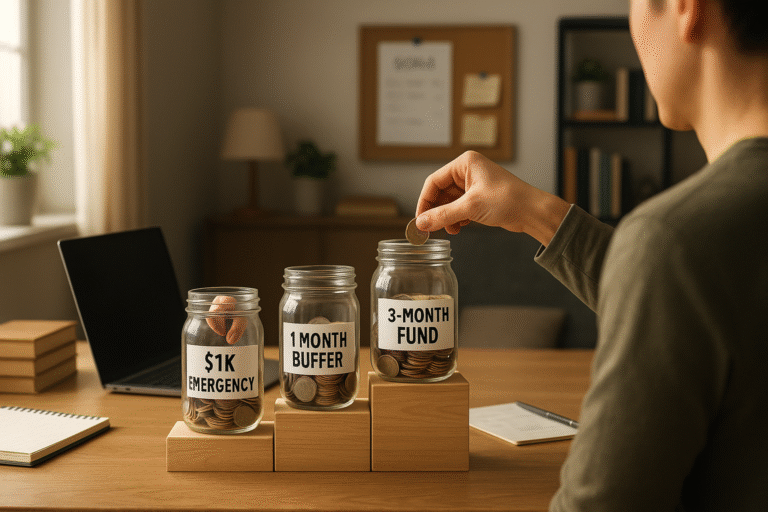Best Places to Keep Short-Term Savings (Ranked by Risk and Access)

Introduction: Why the Right Savings Location Matters
Where you park your short-term savings isn’t just a convenience—it’s a strategy. Whether you’re saving for an upcoming move, a medical deductible, or a new car, your money needs to be both safe and accessible.
Not all savings accounts are created equal. Choosing the right place can mean the difference between earning nothing or boosting your cash with interest while still being able to reach it quickly.
In this guide, we rank the top options for short-term savings based on three criteria: liquidity, safety, and yield. Let’s break down your smartest options.
What Counts as “Short-Term Savings”?
Short-term savings typically refer to money you’ll need in the next 3 to 18 months. These aren’t long-term investments or retirement funds—they’re for goals like:
- Emergency funds
- Vacations or weddings
- Upcoming large purchases
- Moving or job transition reserves
This money should never be exposed to high risk or locked up for years.
The 3 Priorities: Liquidity, Safety, and Yield
Before choosing where to stash your savings, prioritize:
- Liquidity: How fast can you access the cash?
- Safety: Is the money FDIC-insured or government-backed?
- Yield: Does it earn interest above inflation?
Most people need a mix of all three, but tradeoffs are common. That’s why a combo strategy is often best.
How to Assess Risk vs. Access for Your Cash
When you park your cash, you’re balancing risk and reward. For short-term needs, you want ultra-low risk—even if it means slightly lower yield.
Ask yourself: Can I access this money in 1–3 days? Is it protected if the provider fails? Is it earning at least 3–4% APY?
These filters will help narrow down the best-fit option for each financial goal.
1. Traditional Savings Accounts: Easy but Low Yield
Most people start here—and for good reason. Brick-and-mortar savings accounts are simple, safe (FDIC-insured), and fully liquid.
The downside? Pathetically low interest rates—often under 0.10% APY. You’re essentially losing money to inflation.
Use traditional savings only for Stage 1 emergency funds or absolute convenience.
2. High-Yield Savings Accounts (HYSAs): Best for Balance
Online HYSAs often offer 4.0–5.0% APY with full liquidity and FDIC insurance. These are ideal for short-term savings goals and emergency funds beyond $1,000.
Banks like Ally, SoFi, and Marcus are popular options. These accounts are easy to open and often have no fees.
This is the #1 recommended location for most short-term cash.
3. Credit Union Savings Accounts: Community-Focused Alternatives
Credit unions often pay better rates than traditional banks and offer member-friendly service. They’re NCUA-insured, which is the credit union equivalent of FDIC.
You may get rates around 1.5–2.5% APY depending on the institution. Great for savers who prefer a local touch or want to support their community.
Check eligibility, as some unions have location or employment requirements.
4. Online-Only Banks: Higher Interest, Lower Overhead
Chime, Varo, and Discover offer full-service banking without the brick-and-mortar costs. That means better rates passed to you.
Expect 3–5% APY on savings and instant mobile access. These banks are FDIC-insured but may lack physical customer service.
Ideal for digital natives comfortable with mobile-first finance.
5. Money Market Accounts: Savings + Limited Flexibility
Money Market Accounts (MMAs) blend savings and checking features. You’ll get a debit card and limited check-writing privileges—but also better APY than basic savings.
Rates range from 1.5–3.5% APY. FDIC-insured if held at a bank.
These work well if you want to grow your savings but need occasional access.
6. Short-Term CDs: Safe, But Less Accessible
Certificates of Deposit (CDs) lock your money for a fixed period (3–12 months). In return, you get a guaranteed rate—often 4.0–5.0% APY on short terms.
The downside? Early withdrawals cost you interest penalties. Not ideal for funds you might need suddenly.
Great for portioning funds you’re confident you won’t touch for 6–12 months.
7. Treasury Bills (T-Bills): Government-Backed Stability
Treasury bills are short-term U.S. government securities. They mature in 4 to 52 weeks and are backed by the full faith of the U.S. government.
Rates are competitive (around 5% as of mid-2025) and can be purchased via TreasuryDirect.gov.
Solid for conservative savers who want guaranteed safety without bank involvement.
8. Cash Management Accounts: Fintech Flexibility
CMAs from apps like Wealthfront or Betterment pool your funds across partner banks to maximize yield and insurance coverage (often above $1M).
You’ll earn 4–5% APY and have mobile access with limited withdrawal rules.
Ideal for tech-savvy savers who want automation, visibility, and better-than-bank rates.
9. Prepaid Cards with Savings Features: Limited, but Useful
Some prepaid cards offer attached savings accounts—useful for those with limited banking access. Providers like Netspend offer up to 5% APY (on balances up to $1,000).
However, fees can be high, and features are limited. These are stopgap solutions, not long-term tools.
Use only if you’re unbanked or rebuilding your financial foundation.
10. Under-the-Mattress? When (and Why) to Avoid It
Keeping cash at home may feel secure, but it’s vulnerable to theft, loss, or disaster—and earns zero interest.
If you do keep a small stash, limit it to $100–$200 and store it safely. Everything else belongs in an insured, interest-earning account.
Safety and growth go hand in hand when planning for the future.
Best Combo Strategy: Layering Your Savings
Don’t put all your short-term money in one place. Try a layered approach:
- $500–$1,000: In a traditional or HYSA for ultra-fast access
- 1–2 months of expenses: In a HYSA or CMA
- 3–12 months: In T-Bills or short-term CDs
This gives you immediate liquidity, medium-term access, and longer-term growth—all protected and smartly placed.
Conclusion: Park Smart, Not Just Safe
Your short-term savings deserve more than a dusty corner of your checking account. By strategically choosing where you store your cash, you give every dollar more power—without sacrificing safety.
Want to know how much you should be saving each month? Read our guide: How Much Should You Keep in Your Emergency Fund?
FAQs
1. What is the best place to keep short-term savings?
High-yield savings accounts (HYSAs) are generally the best choice due to their balance of access, safety, and interest.
2. Is it safe to use online-only banks?
Yes. As long as they are FDIC-insured, online-only banks are just as safe as traditional ones—and often offer better rates.
3. Can I lose money in a money market account?
Not typically. Most MMAs are FDIC-insured and behave like savings accounts, though some investment MMAs carry risk.
4. Should I invest my short-term savings?
No. Investing short-term savings in stocks or crypto exposes it to volatility. Keep short-term cash in stable, liquid accounts.
5. Are Treasury Bills a good short-term savings option?
Yes. T-Bills are government-backed, low-risk, and often pay competitive rates with terms of 4 to 52 weeks.
Additional Resources
- How Much Should You Keep in Your Emergency Fund? — get clarity on ideal savings targets across income levels.
- 10 Highest-Paying Side Hustles to Start in 2025 — perfect to grow your short-term savings fast with low-risk income streams.
- Step-by-Step Budgeting: How to Build a Budget That Actually Works — create a monthly plan that frees up more money for savings without sacrifice.
- Investopedia – Best High-Yield Savings Accounts — compare top online banks offering 4.0–5.0% APY with FDIC protection.
- TreasuryDirect.gov – Buy U.S. Treasury Bills — invest in low-risk T-Bills directly from the federal government, no broker needed.








